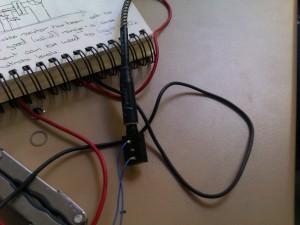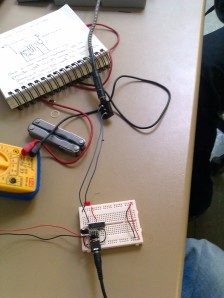Well what can I say; Its been a productive day.
Today Mike and myself set out to create our experimental guitar signal meter.
The day was off to a little bit of a rocky start for a few reasons;
After lugging all the kit – 2 laptops, one guitar + cables, tools, breadboard and electronics and donor material (Marshall amp)
I realised I’d forgotten our multimeter – So theres one trip home.
After returning I thought I’d tune the guitar – and promptly snapped the ‘b’ string. Great
And to top it all off I couldnt source a MOSFET transistor.
But nevermind; we got off to a flying start – Mike researched use of our transistor for amplification while I popped off and unsoldered the Mono Jack we needed to use to accept the guitar input.
After having this we rechecked the polarity of the signal coming in to the Jack using the multimeter so wires could be soldered and plugged into the appropriate spots on the breadboard.
At this point our circuit looked like this:
Now although I predicted that the output signal of the guitar alone would be too weak for the stamp to measure we used the programmers debug command to watch the readings in real time; which yielded some suprising results:
The debug console was showing readable results (although very low) – but still; these readings will do just fine for todays experiment – so we done what any other self respecting designer would do – made a light flash…Just because we could. This concerned programming a simple “If” statement into the stamp – basically saying that if the stamp read anything over a background noise level – to light the Red LED. The results? We’ve got a video for that too!
Now that we are confident we could turn an analog input into a digital output – we set to split the signal into three ranges. Unfortunetly because of the weakness of the signal the ranges would be relatively small and innacurate – but there was a definate proof in the code.
In the end the code that we had looked a little (well, exactly) like this:
 So – There you have it – another successful venture.
So – There you have it – another successful venture.
Next we will be hunting down and capturing a MOSFET transistor – and amplifying the signal to get a more useful, accurate range out of the signal – then doing something fun with it!
Stay classy internet
– Allan and Mike



So you guys know, I’m pretty sure you can make the coding more reactive over a small range (basically you take the 1-256? or whatever its going up to) and make it then only read like 1-50 (or whatever the highest number you are getting is) then it splits that range back into 1-256 so you basically get a much more sensitive, but just as wide range of readings… i can’t remember the coding for it myself but it should be on the internet or someone clever will probably know…
Thanks for the pointer Tom – We’ve been told that we can increase the range and therefore the resolution on the chip; So we’ll be trying again this week!